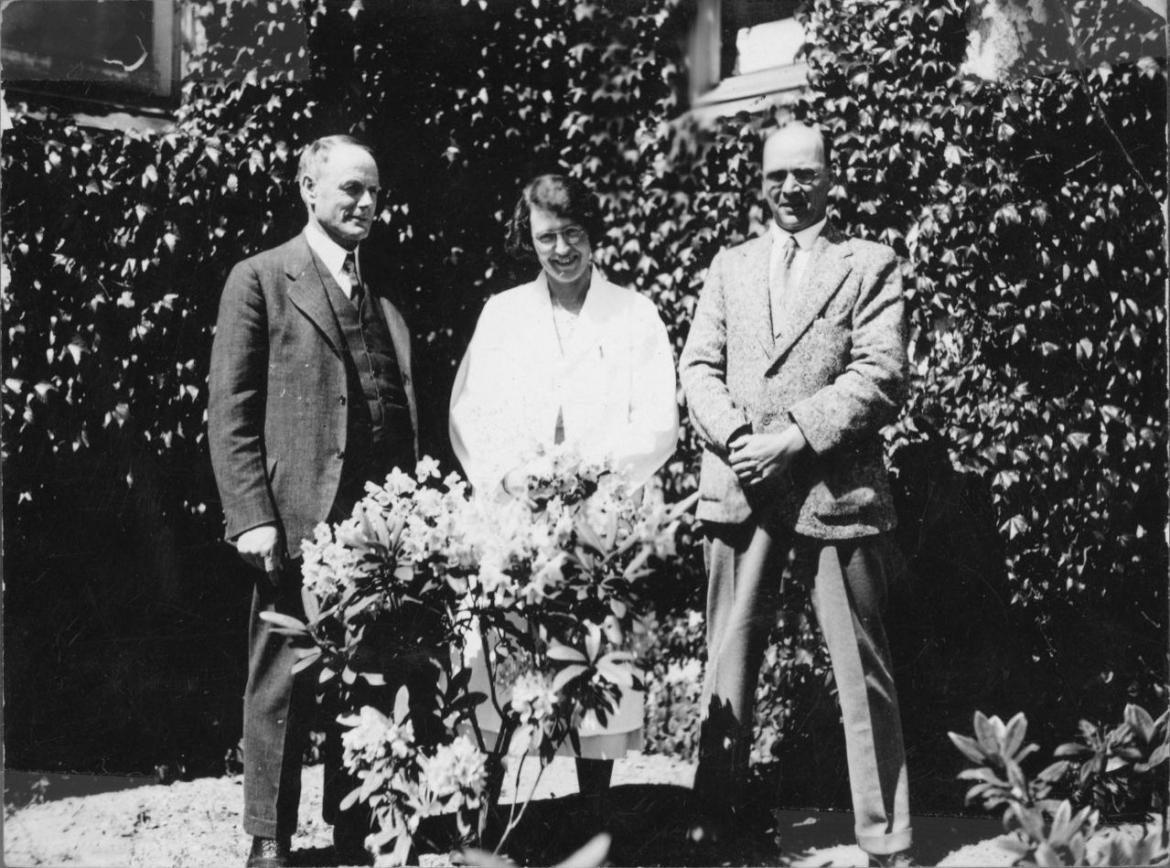On the 30 September 1915, The University of British Columbia opened its doors to 379 students. The first biology courses were offered in 1916, in a small department of Biology headed by Professor Andrew Hutchinson. In 1920, McLean Fraser was appointed to teach zoology and in 1924 became first Professor and Head of the new fledgling Zoology Department. To help him in this endeavour he hired Dr. Gertrude M. Smith, and Dr. George J. Spencer and they became the three "pioneers" (see William Hoar's scrap book image below), when the Hutchinson Department (Botany and Biology) expanded its scope in 1939 to include vertebrate and invertebrate course. At that time genetics and physiology courses were taught only in the Hutchinson (Biology and Botany) Department. Gertrude Smith taught the UBC Courses then called: Zoology 1or General Morphology; Zoology 2 or Comparative Anatomy of Vertebrates; Zoology 3 or Comparative Anatomy of Invertebrates and Zoology 6 or Embryology. Dr Spencer was an entomologist and the entomological collection at the Beaty Biodiversity Museum still bears his name. Dr. McLean's passion was hydroids. Prior to joining UBC, he worked on all aspects of the marine environment including commercially important fish and invertebrate species aswell as the impart of marine mammals and imparted this knowledge in his classes.
Dr McLean Fraser was succeeded in 1940 by Wilbert Clemens as Head of Zoology, a department with three professors. William Hoar joined the Department in 1945 as professor of Zoology and Fisheries. A rapid period of growth and expansion followed in the post-war era. In the 1960s, under the leadership of Ian McTagert Cowan and Bill Hoar, the Department of Zoology expanded into Physiology, Genetics, Ecology, and Parasitology with a growing complement of professors. During this time the first women woman to receive a PhD in Zoology, Dr. Vivien Srivastava, graduated in 1964. However it wasn’t until Associate Professor Dr. J. Mary Taylor was hired that a woman was eligible for tenure in the Department of Zoology. The third women faculty member Dr. Judy Myers was hired in 1972 and it would take another 20 years before another women was hired, Dr. Linda Matsuuchi in 1990. Over the next twenty years to the present time, the Department has expanded greatly with an increase in diversity in both research interests and faculty complement. There are now 17 research faculty women (representing 39% of the research faculty) and the Department appointed the first women Head, Dr. Vanessa Auld, in 2018.
Research interests of our current faculty fall into four overlapping disciplines within the life sciences: evolutionary biology, ecology and conservation biology, comparative physiology, and cell and developmental biology. Prior to 2005 all Zoology research spaces were in either the old Biosciences Building (constructed 1948-1975) or the Ecology “huts” (remnants of WWII). With the emergence of the CFI program and subsequent new construction and renovations, the department relocated into modern research spaces that provide state-of-the-art shared facilities and proximity to colleagues with like interests. Research faculty are now housed in four different buildings in a manner that promotes interaction with researchers in similar disciplines from different departments and faculties. With the construction of the new Undergraduate Life Sciences Teaching building our Educational Leadership faculty will be able to move into an integrated space that will allow them to showcase and expand their pedagogical initiatives.

Photo: "The Pioneers: C McLean Fraser, Gertrude Smith, and George Spencer. Until 1939"
"In the beginning, it was a Biology Department.
McLean Fraser; Director of the Nanaimo Station taught Zoology in the winter. In 1924, he became Head of a newly established Zoology Department.
Gertrude Smith, George Spencer and sometimes Edith Berkeley taught various courses - but only the morphological x systemic. Genetics and Physiology remained in the Hutchinson Department - Biology and Botany.
McLean Fraser retired in 1939 and Gertrude Smith also. George Spencer retired in 1953."
